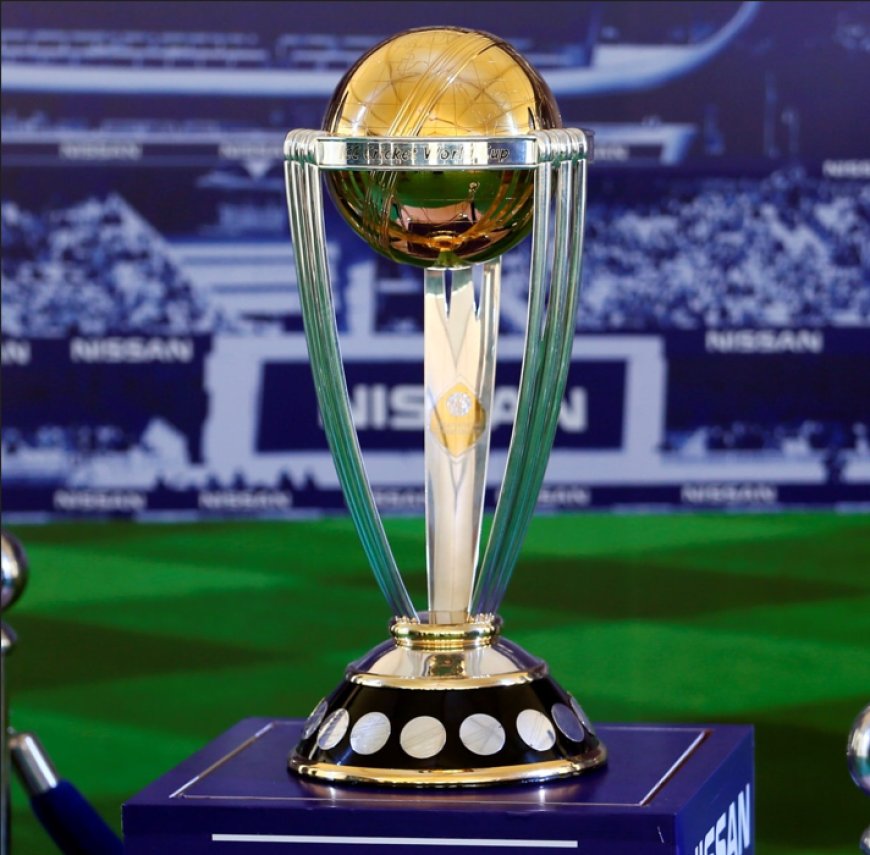"Cricket's Grand Spectacle: A Chronicle of the World Cup through Time"
The Cricket World Cup stands as the pinnacle of international cricket, a tournament that transcends boundaries and unites nations in the pursuit of sporting glory. Since its inception, the tournament has become a coliseum where cricketing titans clash, showcasing skill, strategy, and unyielding determination. This quadrennial spectacle is not just a series of matches; it's a narrative woven with the threads of passion, rivalry, and the relentless pursuit of the coveted trophy.

TABLE OF CONTENT :-
· Introduction
· Inception and Early Years (1975-1983):
· The Rise of Australia and Subcontinental Glory (1987-1996):
· Turn of the Century: Australia's Dominance (1999-2007):
· Shift in Power Dynamics and Upsets (2011-2015):
· Recent Years: England's Triumph and the Rise of New Contenders (2019-present):
. A Recap of the 2023 Cricket World Cup:
. Conclusion
Introduction:
The history of the Cricket World Cup is a captivating journey that mirrors the evolution of the sport itself. Since its inception in 1975, the tournament has grown into a global phenomenon, captivating the hearts of cricket enthusiasts worldwide. In this blog, we'll embark on a historical voyage through the Cricket World Cup, exploring its origins, iconic moments, and the evolution of the tournament over the decades.
Inception and Early Years (1975-1983):
The idea of a global cricket championship was conceived in the early 1970s, and it finally materialized in 1975 with the inaugural Cricket World Cup held in England. Eight teams, including traditional powerhouses like Australia, West Indies, and England, participated in the tournament that laid the foundation for future cricketing extravaganzas.
The West Indies, led by Clive Lloyd, emerged as the first-ever champions, showcasing the dominance they would exert over the next decade. The 1979 edition, hosted again by England, saw the West Indies retain their title, solidifying their status as cricket's powerhouse.
The 1983 World Cup, hosted by England, marked a turning point in the history of the tournament. In a stunning upset, Kapil Dev's Indian team defeated the mighty West Indies in the final, introducing an element of unpredictability that would become a hallmark of future World Cups.
The Rise of Australia and Subcontinental Glory (1987-1996):
The late 1980s and early 1990s witnessed a shift in cricketing power dynamics. Australia, under the leadership of Allan Border, rose to prominence, clinching their first World Cup title in 1987. This victory marked the beginning of Australia's cricketing dominance on the world stage.
The 1992 World Cup in Australia and New Zealand brought another significant change—the introduction of floodlit day-night matches and colored clothing. Pakistan, led by Imran Khan, emerged as the champions in a memorable final against England, further diversifying the list of cricketing giants.
The 1996 World Cup, co-hosted by India, Pakistan, and Sri Lanka, witnessed the emergence of subcontinental cricket. Sri Lanka, under the captaincy of Arjuna Ranatunga, secured their maiden World Cup triumph. This victory was a moment of pride for the entire subcontinent, solidifying the region's cricketing prowess.
Turn of the Century: Australia's Dominance (1999-2007):
As the cricketing world entered the new millennium, Australia continued its World Cup dominance. Led by captains like Steve Waugh and Ricky Ponting, the Australian team clinched three consecutive titles in 1999, 2003, and 2007. During this period, Australia's team boasted legends like Shane Warne, Glenn McGrath, and Adam Gilchrist, creating an era of unparalleled success.
The 2003 World Cup in South Africa witnessed a memorable moment as Sachin Tendulkar, one of the greatest batsmen in the history of the game, became the first player to score 10,000 runs in One Day Internationals. Despite individual brilliance, Australia maintained their stranglehold on the trophy.
Shift in Power Dynamics and Upsets (2011-2015):
The 2011 World Cup, hosted by India, Sri Lanka, and Bangladesh, marked a shift in power dynamics. India, led by MS Dhoni, emerged as the champions, lifting the trophy on home soil. The tournament showcased the rise of teams like India, Sri Lanka, and South Africa, challenging the traditional cricketing powerhouses.
The 2015 World Cup in Australia and New Zealand brought several upsets, with Bangladesh defeating England and Ireland stunning the West Indies. Australia reclaimed the title under the captaincy of Michael Clarke, reaffirming their prowess in the limited-overs format.
Recent Years: England's Triumph and the Rise of New Contenders (2019-present):
The 2019 World Cup in England was a rollercoaster ride of emotions, culminating in a thrilling final between England and New Zealand. In a dramatic contest that went down to a Super Over, England emerged as the champions, winning their first-ever World Cup. The tournament showcased the growing competitiveness among teams and the importance of adaptability in modern cricket.
Looking ahead, the Cricket World Cup continues to evolve, with new contenders emerging and established teams facing stiff competition. The rise of T20 cricket and the introduction of new formats have added further excitement to the cricketing landscape, promising a future where the World Cup remains a pinnacle event in the sport.
A Recap of the 2023 Cricket World Cup:
Several key moments defined the 2023 Cricket World Cup. One such moment was the stunning century by a rising star from a lesser-known cricketing nation, showcasing the tournament's ability to uncover hidden talents. The intense rivalry matches, filled with electrifying performances and close finishes, kept fans on the edge of their seats. Memorable catches, game-changing innings, and exceptional bowling spells created a tapestry of cricketing brilliance.
As the tournament progressed to the business end, the semi-finals showcased some of the finest cricketing skills. The tension was palpable as teams fought tooth and nail for a coveted spot in the finals. The final itself was a grand spectacle, with the world watching as two cricketing giants battled for supremacy. A heroic innings, a crucial wicket, or a strategic captaincy decision could make all the difference, and the players delivered on the biggest stage.
Conclusion:
The history of the Cricket World Cup is a saga of triumphs, upsets, and moments that have etched themselves into the annals of cricketing lore. From the dominance of the West Indies and Australia to the rise of subcontinental cricket and the recent success of England, the tournament has mirrored the changing landscape of international cricket.
As we eagerly await the next edition of the Cricket World Cup, one thing is certain—the tournament will continue to captivate audiences, inspire future generations of cricketers, and provide a stage for the world's best to showcase their talent on a global scale. The history of the Cricket World Cup is a testament to the spirit of competition, camaraderie, and the enduring magic of the sport that unites nations and cricket enthusiasts across the globe.




